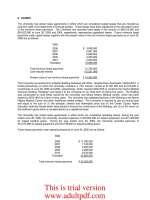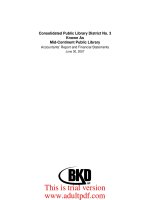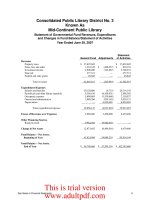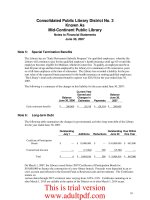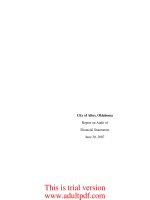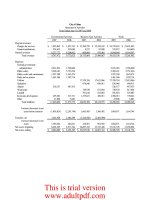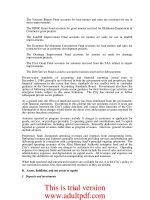WILLIAM MARSH RICE UNIVERSITY CONSOLIDATED FINANCIAL STATEMENTS JUNE 30, 2023 AND 2022 10 ĐIỂM
Bạn đang xem bản rút gọn của tài liệu. Xem và tải ngay bản đầy đủ của tài liệu tại đây (334.87 KB, 29 trang )
<span class="text_page_counter">Trang 1</span><div class="page_container" data-page="1">
<b>William Marsh Rice University Consolidated Financial Statements </b>
<b>June 30, 2023 and 2022 </b>
</div><span class="text_page_counter">Trang 2</span><div class="page_container" data-page="2"><b>Report of Independent Auditors ... 1–2 Consolidated Financial Statements </b>
Statements of Financial Position ... 3 Statements of Activities ... 4 Statements of Cash Flows ... 5 Notes to Financial Statements ... 6–27
</div><span class="text_page_counter">Trang 3</span><div class="page_container" data-page="3"><small>PricewaterhouseCoopers LLP, 1000 Louisiana St., Suite 5800, Houston, TX 77002 T: (713) 356 4000, www.pwc.com/us </small>
<b>Report of Independent Auditors </b>
To theBoard of Trustees of William Marsh Rice University
<i><b>Opinion </b></i>
We have audited the accompanying consolidated financial statements of William Marsh Rice University and its subsidiaries (the “University”), which comprise the consolidated statements of financial position as of June 30, 2023 and 2022, and the related consolidated statements of activities for the year ended June 30, 2023 and of cash flows for the years ended June 30, 2023 and 2022, including the related notes (collectively referred to as the “consolidated financial statements”).
In our opinion, the accompanying consolidated financial statements present fairly, in all material respects, the financial position of the University as of June 30, 2023 and 2022, the changes in its net assets for the year ended June 30, 2023, and its cash flows for the years ended June 30, 2023 and 2022 in accordance with accounting principles generally accepted in the United States of America.
<i><b>Basis for Opinion </b></i>
We conducted our audit in accordance with auditing standards generally accepted in the United States of America (US GAAS). Our responsibilities under those standards are further described in the Auditors’ Responsibilities for the Audit of the Consolidated Financial Statements section of our report. We are required to be independent of the University and to meet our other ethical responsibilities, in accordance with the relevant ethical requirements relating to our audit. We believe that the audit evidence we have obtained is sufficient and appropriate to provide a basis for our audit opinion.
<i><b>Other Matter </b></i>
We previously audited the consolidated statement of financial position as of June 30, 2022, and the related consolidated statements of activities and of cash flows for the year then ended (the consolidated statement of activities is not presented herein), and in our report dated October 31, 2022, we expressed an unmodified opinion on those consolidated financial statements. In our opinion, the information set forth in the accompanying summarized financial information for the year ended June 30, 2022 is consistent, in all material respects, with the audited consolidated financial statements from which it has been derived.
<i><b>Responsibilities of Management for the Consolidated Financial Statements </b></i>
Management is responsible for the preparation and fair presentation of the consolidated financial statements in accordance with accounting principles generally accepted in the United States of America, and for the design, implementation, and maintenance of internal control relevant to the preparation and fair presentation of consolidatedfinancial statements that are free from material misstatement, whether due to fraud or error.
</div><span class="text_page_counter">Trang 4</span><div class="page_container" data-page="4">In preparing the consolidated financial statements, management is required to evaluate whether there are conditions or events, considered in the aggregate, that raise substantial doubt about the University’s ability to continue as a going concern for one year after the date the consolidated financial statements are issued.
<i><b>Auditors’ Responsibilities for the Audit of the Consolidated Financial Statements </b></i>
Our objectives are to obtain reasonable assurance about whether the consolidated financial statements as a whole are free from material misstatement, whether due to fraud or error, and to issue an auditors’ report that includes our opinion. Reasonable assurance is a high level of assurance but is not absolute assurance and therefore is not a guarantee that an audit conducted in accordance with US GAAS will always detect a material misstatement when it exists. The risk of not detecting a material misstatement resulting from fraud is higher than for one resulting from error, as fraud may involve collusion, forgery, intentional omissions, misrepresentations, or the override of internal control. Misstatements are considered material if there is a substantial likelihood that, individually or in the aggregate, they would influence the judgment made by a reasonable user based on the consolidated financial statements.In performing an audit in accordance with US GAAS, we:
● Exercise professional judgment and maintain professional skepticism throughout the audit. ● Identify and assess the risks of material misstatement of the consolidated financial statements,
whether due to fraud or error, and design and perform audit procedures responsive to those risks. Such procedures include examining, on a test basis, evidence regarding the amounts and
disclosures in the consolidated financial statements.
● Obtain an understanding of internal control relevant to the audit in order to design audit procedures that are appropriate in the circumstances, but not for the purpose of expressing an opinion on the effectiveness of the University's internal control. Accordingly, no such opinion is expressed.
● Evaluate the appropriateness of accounting policies used and the reasonableness of significant accounting estimates made by management, as well as evaluate the overall presentation of the consolidated financial statements.
● Conclude whether, in our judgment, there are conditions or events, considered in the aggregate, that raise substantial doubt about the University’s ability to continue as a going concern for a reasonable period of time.
We are required to communicate with those charged with governance regarding, among other matters, the planned scope and timing of the audit, significant audit findings, and certain internal control-related matters that we identified during the audit.
October 31, 2023
</div><span class="text_page_counter">Trang 5</span><div class="page_container" data-page="5"><b>Consolidated Statements of Financial Position June 30, 2023 and 2022 </b>
The accompanying notes are an integral part of these consolidated financial statements.
<b><small>Net assets</small></b>
<b><small>RestrictionsRestrictions20232022Net Assets</small></b>
<small>Internally designated$ 246,294$ -$ 246,294$ 253,175</small>
<small>Endowment and designated</small>
<small>Total net assets$ 3,828,440$ 4,772,545$ 8,600,985$ 8,754,434</small>
</div><span class="text_page_counter">Trang 6</span><div class="page_container" data-page="6"><b><small>Operating revenues</small></b>
<small>Allocation of endowment spending$ 374,833$ -$ 374,833$ 335,108</small>
<b><small>Nonoperating changes</small></b>
<small>Gifts, grants, and pledges for property and endowment6,94654,08861,034128,506</small>
<small>Allocation of endowment spending to operations(177,730)(197,103)(374,833)(335,108)</small>
<b><small>Net assets</small></b>
<b><small>2023</small></b>
</div><span class="text_page_counter">Trang 7</span><div class="page_container" data-page="7"><b>Consolidated Statements of Cash Flows For the Years Ended June 30, 2023 and 2022 </b>
The accompanying notes are an integral part of these consolidated financial statements.
<b><small>Cash flows from operating activities</small></b>
<small>Total decrease in net assets$ (153,449)$ (169,201)Adjustments to reconcile changes in net assets to</small>
<small> net cash used in operating activities</small>
<small>Depreciation of property and equipment 78,85073,899Loss on disposal of property and equipment 53386Net realized and unrealized investment (gain) loss (66,589)91,428Contributions restricted for long term purposes and noncash contributions (89,298)(93,591)Change in fair value of commodity swap agreements(120)(678)Actuarial change and income restricted for life-income agreements6,351(15,681)Change in</small>
<small>Accounts receivable and other assets(17,458)(23,902)</small>
<small>Accounts payable and other liabilities12,737(15,907)Net cash used in operating activities(205,829)(173,691)</small>
<b><small>Cash flows from investing activities</small></b>
<small>Proceeds from sales and maturities of investments984,0941,397,650</small>
<small>Purchases of property and equipment(147,921)(118,296)Net cash provided by investing activities116,590102,123</small>
<b><small>Cash flows from financing activities</small></b>
<small>Contributions restricted for endowment81,48765,955</small>
<small>Contributions restricted for trusts and other114725Changes in life income agreements from income and payments to beneficiaries(9,804)(13,639)Proceeds from issuance of tax-exempt commercial paper29,17512,880Payment of outstanding tax-exempt commercial paper(10,035)(8,730)Decrease in government refundable advances(528)(697)Net cash provided by financing activities98,10683,405Net increase in cash and cash equivalents8,86711,837</small>
<b><small>Cash and cash equivalents</small></b>
</div><span class="text_page_counter">Trang 8</span><div class="page_container" data-page="8"><b>1. Basis of Presentation and Summary of Significant Accounting Policies Basis of Presentation </b>
William Marsh Rice University (the “University”) is a Texas not-for-profit corporation that operates a private research university in Houston, Texas. The consolidated financial statements of the University have been prepared on the accrual basis of accounting, in accordance with accounting principles generally accepted in the United States of America and with the provisions of the Financial Accounting Standards Board (“FASB”) Accounting Standards Codification (ASC) 958, Not-for-Profit Entities, which requires the University to classify its net assets into two categories according to donor-imposed restrictions: net assets without donor-imposed restrictions and net assets with donor-imposed restrictions. All material transactions between the University and its subsidiaries have been eliminated.
The financial statements include certain prior year summarized comparative information in total but not by net asset class. Such information does not include sufficient detail to constitute a
presentation in conformity with accounting principles generally accepted in the United States of America. Accordingly, such information should be read in conjunction with the University’s financial statements for the year ended June 30, 2022, from which the summarized information was derived. The consolidated financial statements of the University include the accounts of all academic and administrative departments of the University and affiliated organizations that are controlled by the University.
<b>Net Assets Without and With Donor Restrictions </b>
Net assets without donor restrictions are those net assets of a not-for-profit entity that are not subject to donor-imposed restrictions. A donor-imposed restriction is a donor stipulation that specifies a use for a contributed asset that is more specific in purpose or time than broad limits resulting from the following: a) the nature of the not-for-profit entity; b) the environment in which it operates; and c) the purposes specified in its articles of incorporation or bylaws or comparable documents.
The classification of net assets without donor restrictions includes all revenues, gains and expenses not restricted by donors. The University reports all expenditures in this class of net assets, since the use of restricted contributions in accordance with donors’ stipulations results in the release of the restriction.
Those net assets of a not-for-profit entity that are subject to donor-imposed restrictions include contributions for which donor-imposed restrictions have not been met (primarily future capital projects; endowment appreciation; life income trusts; and pledges receivable).
</div><span class="text_page_counter">Trang 9</span><div class="page_container" data-page="9"><b>Notes to Consolidated Financial Statements June 30, 2023 and 2022 </b>
<i>(all dollar amounts in thousands) </i>
<b>Measure of Operations </b>
The University’s measure of operations as presented in the consolidated statements of activities includes the allocation of endowment spending for operations, revenue from tuition and fees (net of financial aid), grants and contracts, donor contributions for operating programs, revenue from auxiliary operations, and other revenues. Operating expenses are reported on the consolidated statements of activities by natural classification. The University’s nonoperating activity within the consolidated statements of activities includes: investment returns, net of taxes and other activities related to endowment management; changes in the liability for life-income agreements;
contributions related to land, buildings and equipment; gains or losses on derivatives; and other infrequent items that do not support the teaching and research mission of the University.
<b>Contributions </b>
Contributions, including unconditional promises to give and irrevocable trusts held by others under which the University is the beneficiary, are recognized as revenues in the period received or promised. Contributions restricted for the acquisition of land, buildings and equipment are reported as donor-restricted revenues. These contributions are reclassified to net assets without restriction when the assets are placed in service. Promises to give that are subject to donor-imposed stipulations that the corpus be maintained in perpetuity are recognized as increases in net assets with donor restrictions.
It is the University’s practice to sell marketable securities received as donations upon receipt. In the Consolidated Statements of Cash Flows, the University classifies cash receipts from the sale of donated marketable securities in a manner that is consistent with cash donations received if the donated marketable securities are converted into cash on receipt or shortly thereafter.
Conditional promises to give are not recognized until the conditions on which they depend are met. Contributions of assets other than cash are reported at their estimated fair value at the date of gift. Contributions scheduled to be received after one year are discounted using a market rate (Note 3). Amortization of the discount is recorded as contribution revenue.
<b>Cash and Cash Equivalents </b>
The University considers all highly liquid financial instruments with an original maturity of 90 days or less to be cash equivalents, except those amounts assigned to its investment managers and unspent bond and commercial paper proceeds, which are classified as investments.
<b>Investments and Other Financial Instruments </b>
Investments are made within guidelines authorized by a group of individuals consisting of both trustees and nontrustees appointed by the University’s Board of Trustees. The University’s Board of Trustees retains overall fiduciary responsibility. Investments are initially recorded at cost at date of acquisition or fair value at date of donation in the case of gifts. Ownership of marketable
securities is recognized as of the trade date. Marketable securities transactions that have not settled are recognized as accounts receivable or accounts payable until the settlement date. Endowment income is calculated net of internal and external investment management expenses, including the investment income excise tax.
Investments are stated at fair value. Fair value is defined as the price that would be received for an asset or paid to transfer a liability (an exit price) in the principal or most advantageous market for the asset or liability in an orderly transaction between market participants on the measurement date.
</div><span class="text_page_counter">Trang 10</span><div class="page_container" data-page="10">The hierarchy of valuation inputs is based on the extent to which inputs are observable in the marketplace. Observable inputs reflect market data obtained from sources independent of the University and unobservable inputs reflect assumptions about how market participants would value an asset or liability based on the best information available. Valuation techniques used to measure fair value maximize the use of observable inputs and minimize the use of unobservable inputs. The fair value hierarchy is based on three levels of inputs, of which the first two are considered observable and the last is unobservable, that may be used to measure fair value.
The following describes the hierarchy of inputs used to measure fair value and the primary
valuation methodologies used by the University for financial instruments measured at fair value on a recurring basis (Note 7). The three levels of inputs are as follows:
Level 1 Quoted prices in active markets for identical assets or liabilities, such as exchange-traded equity securities.
Level 2 Inputs other than Level 1 that are observable, either directly or indirectly, such as quoted prices for similar assets or liabilities, quoted prices in markets that are not active, or other inputs that are observable or can be corroborated by observable market data for substantially the same term of the assets or liabilities, including corporate bonds and most Treasury securities.
Level 3 Unobservable inputs, such as valuations supplied by the investment managers, that are supported by little or no market activity and that are significant to the fair value of the assets or liabilities, including investments in certain hedge strategies and all private market strategies.
A financial instrument’s categorization within the valuation hierarchy is based upon the lowest level of input that is significant to the fair value measurement.
In addition to these three valuation methodologies, as a practical expedient, the University is permitted under accounting principles generally accepted in the United States of America (“GAAP”) to estimate the fair value of its investments with external managers using the external managers’ reported net asset value (“NAV”) without further adjustment unless the University expects to sell the investment at a value other than NAV or the NAV is not calculated in accordance with GAAP. The estimated fair value of certain alternative investments, such as private equity and other limited partnership interests, is based on valuations provided by the general partners or partnership valuation committees. These valuations consider variables such as financial performance of investments, recent sale prices of similar investments and other pertinent information. The University reviews and evaluates the data used in determining fair value, including the valuation methods, assumptions, and values provided by the investment managers. Because alternative investments are not readily marketable, their estimated fair value is subject to uncertainty and therefore may differ from the value that would have been used had a ready market for such investments existed. These differences could be material.
Direct investments in natural resources, specifically timberland and oil and gas, as well as real estate are primarily valued using a combination of independent appraisals and/or one or more industry standard valuation techniques (e.g., income approach, market approach, or cost
approach). The income approach is primarily based on the investment’s anticipated future income
</div><span class="text_page_counter">Trang 11</span><div class="page_container" data-page="11"><b>Notes to Consolidated Financial Statements June 30, 2023 and 2022 </b>
<i>(all dollar amounts in thousands) </i>
using one of two principal methods: the discounted cash flow method or the capitalization method. Inputs and estimates developed and utilized in the income approach may be subjective and require judgment regarding significant matters such as estimating the amount and timing of future cash flows and the selection of discount and capitalization rates that appropriately reflect market and credit risks. The market approach derives investment value through comparison to recent and relevant market transactions with similar investment characteristics. The cost approach is utilized when the cost of the investment is determined to be the best representation of fair value. This method is typically used for newly purchased or undeveloped assets. The valuation process encompasses a wide range of procedures that in the aggregate allow the University to assert as to the adequacy of the fair values reported as of the measurement date.
Derivative financial instruments are recorded in the Consolidated Statements of Financial Position as either an asset or liability measured at fair value as of the reporting date. Derivative financial instruments consist of energy hedge agreements. Changes in fair value of these derivatives are recognized in the Consolidated Statements of Activities as other nonoperating changes.
The University’s investments are exposed to a number of risks including interest rate, market, and credit risks. Due to the level of risk exposure, it is possible that changes in the valuation of these investments may occur in the near term and that such changes could be material.
<b>Property and Equipment </b>
Property used by the University is stated at cost for purchased assets and fair value at the date of donation in the case of gifts. Interest expense incurred during the period of construction of an asset for University use is capitalized until that asset is substantially completed and ready for use. The University depreciates its physical assets using the straight-line method over their estimated useful lives. Repairs and maintenance of property and equipment are expensed as incurred. Property and equipment are removed from the records at the time of disposal. Any resulting gain or loss on disposal is recognized in the Consolidated Statements of Activities.
Works of art, historical treasures, literary works and artifacts are preserved and protected for educational, research and public exhibition purposes. Donations and purchases of such collections are recorded for financial statement purposes as property and equipment but are not depreciated.
<b>Asset Retirement Obligations </b>
The University recognizes asset retirement obligations (“AROs”) that are conditional on a future event, such as the legal obligation to safely dispose of asbestos when a building is remodeled or demolished. The University measures conditional AROs at estimated fair value using a probability weighted, discounted cash flow model with multiple scenarios, if applicable. The present value of weighted, discounted cash flows is calculated using credit-adjusted, risk-free rates applicable to the University in order to determine the estimated fair value of the conditional AROs.
<b>Life Income Agreements </b>
Life income agreements include charitable remainder trusts and gift annuities. Charitable remainder trusts hold donated assets for which the University’s subsidiary acts as trustee and periodically pays specified amounts to the designated beneficiaries. Generally, beneficiary payments are a fixed amount for annuity trusts and a fixed percentage of the fair value of the trust assets or based on income earned for other charitable remainder trusts. At a date specified in each gift instrument, usually the beneficiary’s date of death, ownership of the trust assets will transfer to the University and the beneficiary payments will cease. The University also enters into
</div><span class="text_page_counter">Trang 12</span><div class="page_container" data-page="12">gift annuity agreements, which require that the University take ownership of the assets at the date of gift with an obligation to periodically pay specified amounts to designated beneficiaries for their lifetimes. Assets held in life income trusts and those assets associated with gift annuities are included in investments at fair value. Contribution revenues are recognized at the date the trusts or gift annuities are established at the net present value calculated based on an actuarial table. Liabilities are recorded at the same time using actuarial tables and discounted according to the risk-free rate at the time of the gift. Discount rates range from 1% to 6%. The liability represents the present value of the estimated future payments to be made to the beneficiaries. The liabilities are adjusted annually for changes in the value of the assets and actuarial changes, which impact the estimates of future payments.
<b>Student Tuition and Fees </b>
Tuition and fees includes amounts charged for degree programs as well as nondegree executive and continuing education programs. Fees are recognized when assessed and tuition revenue is recognized over the period during which the courses are taken. The University has a need-blind admission policy for domestic undergraduate students; and the university meets all financial need of enrolled undergraduate students. Awarded financial aid is applied first to tuition and required fees (see Note 11).
<b>Grants and Contracts </b>
The University receives funding from both government and private sources for research and other programs conducted under grants and contracts. Nearly all revenue from these sources are nonexchange transactions. Revenue associated with nonexchange transactions is recognized as the qualified expenditures are incurred up to the award amount. A limited number of grants and contracts from private sources are considered exchange transactions and are allocated to the University on a calendar basis. Revenue associated with exchange transactions is recognized as the performance obligation is met.
Unearned income from sponsored programs is amounts received by the University under the terms of agreements that generally require the exchange of assets, rights, or privileges between the University and the sponsor. Such funds are advanced for activity that will occur in the near future, generally within the next fiscal year; and are recognized in accounts payable and other liabilities. Most grants and contracts provide for reimbursement of both direct and indirect costs. The recovery of indirect costs, also referred to as facilities and administrative costs, is recognized based on predetermined rates negotiated with the federal government or amounts set by nonfederal sponsors.
<b>Gifts and Pledges </b>
Gifts and pledges (contributions) are recognized when received. Gifts of securities are recorded at their fair value at the date of contribution. Nonfinancial gifts received from donors are put into use and recorded by the University at fair value. Pledges consist of unconditional promises to
contribute to the University over an agreed upon schedule. Pledges, trusts, and remainder interests are reported at their estimated fair values.
The University records items of collections (such as books or manuscripts) as gifts at fair value. In general, collections are only received for educational or research purposes and are not disposed of for financial gain or otherwise encumbered in any manner.
</div><span class="text_page_counter">Trang 13</span><div class="page_container" data-page="13"><b>Notes to Consolidated Financial Statements June 30, 2023 and 2022 </b>
<i>(all dollar amounts in thousands) </i>
<b>Auxiliary Enterprises </b>
Revenues from auxiliary operations, which include student housing, dining, transportation and parking, are recognized over the period during which the services are provided. To the extent financial aid is awarded to students in excess of their tuition and required fees, it is next applied to room and board charges (see Note 11).
<b>Other Revenues </b>
Other revenues primarily consist of athletics revenues and revenues related to sales of nontuition based goods and services (e.g. textbooks, conferences, consortia fees, concerts, etc.). Other revenues related to exchange contracts are recognized as the University fulfills the terms of the agreements, which generally span less than one year. Other revenue related to nonexchange contracts is recognized as received.
<b>Credit Risk </b>
The University maintains operating cash and other cash balances in financial institutions that from time to time may exceed federally insured limits. The University periodically assesses the financial condition of these institutions and believes that the risk of loss is minimal.
The University has evaluated the credit risk associated with financing receivables, primarily student loans, and determined that both the receivables and the related allowances are immaterial to the financial statements.
<b>Tax Status </b>
The University is exempt from federal income tax to the extent provided under Section 501(c)(3) of the Internal Revenue Code. The IRS issued a determination letter in January 1938 that recognized the University as exempt from federal income tax under Section 501(c)(3). The IRS confirmed in 2008 that this exemption still applies.
The University has 11 subsidiary corporations that are included in the consolidated financial statements. Two of these subsidiary corporations are exempt from federal income taxes under 501(c)(2), two are exempt under 501(c)(3), one is exempt under 501(c)(4), four are exempt under 501(c)(25) and two are subject to taxation. The University is classified as an organization that is not a private foundation under Section 509(a) of the Internal Revenue Code because it is described in Sections 509(a)(1) and 170(b)(1)(A)(ii) and, as such, gifts to the University qualify for deduction as charitable contributions to the extent provided by law. The University and its subsidiary corporations that are exempt from federal income tax are required to pay federal income tax on unrelated business income. The amount of income tax expense for unrelated business income for the University and its subsidiary corporations was immaterial for the years ended June 30, 2023 and 2022, respectively.
The University is part of a small group of universities that are subject to an excise tax of 1.4% on the University’s net investment income and the net investment income of its subsidiary
corporations. The excise tax is recognized as a reduction of the University’s investment returns.
</div><span class="text_page_counter">Trang 14</span><div class="page_container" data-page="14">The portion of the excise tax associated with the current period realized gains was $3,876 and $4,847 for the years ended June 30, 2023 and 2022, respectively.
U.S. GAAP requires the University to evaluate its tax positions to recognize a tax liability (or asset) if the University has taken an uncertain tax position that, more likely than not, would not be
sustained upon examination by the IRS. The University has analyzed the tax positions taken and has concluded that as of June 30, 2023, there are no significant uncertain positions taken.
<b>Other Reporting Matters </b>
In March 2020, a national emergency concerning COVID-19 was declared in the United States. The University incurred out-of-pocket pandemic related expenses for the years ended June 30, 2023, 2022 and 2021. These expenses have been or are in the process of being submitted to the Federal Emergency Management Agency (“FEMA”) under its Public Assistance Program for reimbursement. The University can provide no assurances as to the timing or amount, if any, of any reimbursement from FEMA. Accordingly, no amounts related to the reimbursement are recorded until the earlier of cash received or a grant notification from FEMA is received.
The University received awards under the Higher Education Emergency Relief Act, a portion of which was to be used for the direct benefit of students and a portion of which could be used by the University for expenses or lost revenue related to the pandemic. The amount recognized was $0 and $1,339 for the years ended June 30, 2023 and 2022, respectively.
<b>2. Liquidity and Availability </b>
Financial assets available within one year of the balance sheet date for general expenditures, such as operating and capital expenses, are summarized as follows at June 30:
Total financial assets and liquidity
resources available within one year $ 945,275 $ 860,255
<small>(1)</small> The University manages liquidity by structuring financial assets to be available as its general expenditures, liabilities, and other obligations come due. The University invests cash in excess of operational requirements in short-term investments.
<small>(2)</small> Each spring the Board of Trustees appropriates the amount of investments that can be used in the subsequent fiscal year. These funds are available beginning July 1 of each subsequent fiscal year.
</div>

